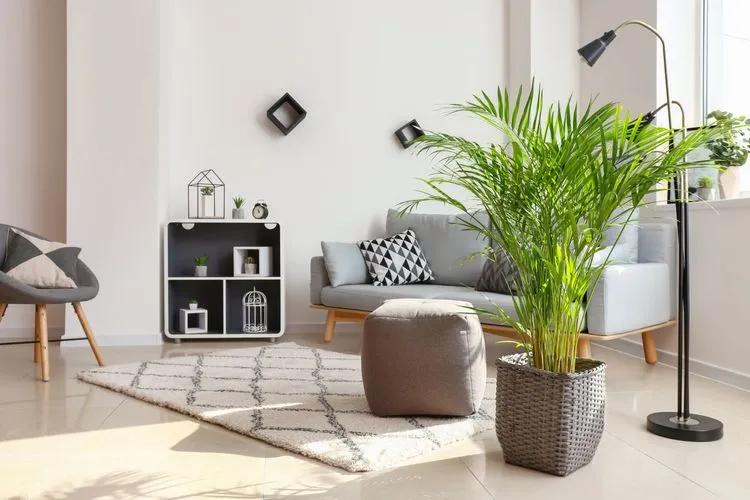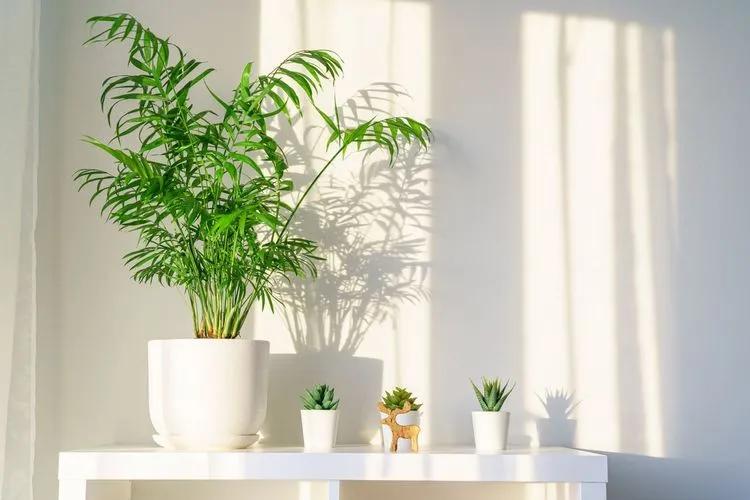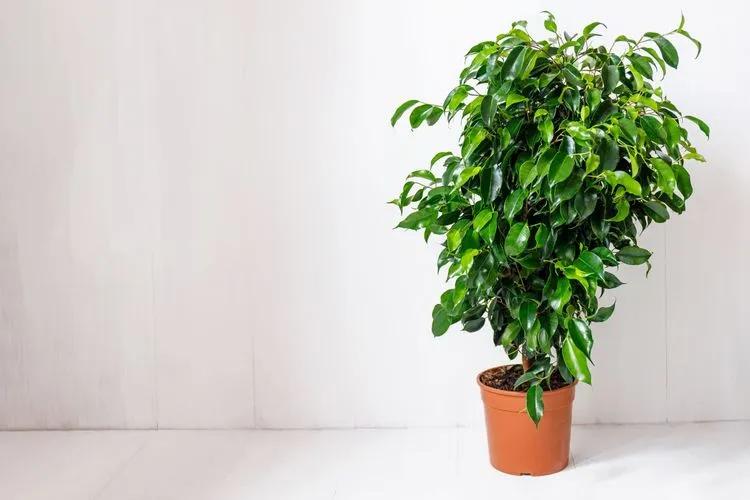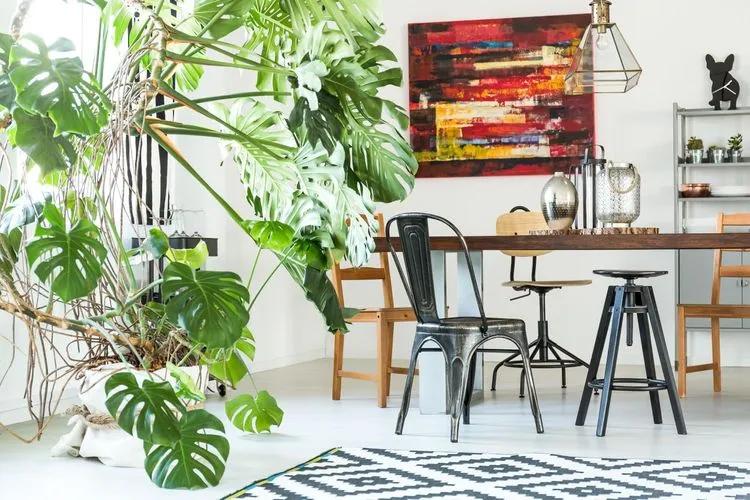Big Indoor Plants to Decorate Your Living Room
Remember all these documentaries about lush rainforests with their rich ecosystem and numerous evergreen plants? You can arrange something similar at home! Indoor plants also help to mask the imperfections of space and fill every centimeter with soulfulness and beauty. Thus, phytodesign not only improves the microclimate of the premises but also makes it possible to transform any home without serious financial investments. Our pick of the best large green plants for your living room will help with this task.

Making Living Room Bigger with Plants
You can create an optical illusion that can change our perception of space in the most voluminous way. Thus, skillful selection and placement of plants can make the interior more balanced and harmonious. Indoor plants will add coziness and freshness to the space, and greenery will bring life to the room and make it visually brighter. To avoid cluttering up the space, it is worth choosing floor pots in the color of the walls.
Plants embellish any design, including a small room. Violets, Cyclamen, Balm, and Spathiphyllum are some of the best examples for this task.
Useful Phytodesign Tips
- Place tiny plants near one or both long walls in groups of 2-6 pieces, depending on the size of the room, if you want to visually expand it. The room will look more spacious.
- A basket suspended from the ceiling with branches descending downward makes the ceiling visually closer. Therefore such baskets should be hung only in rooms with sufficiently high ceilings, at least 8.8-9.8 ft. (2.70-3.00 meters)
- In rooms with the most common ceilings, put a tub with a large plant in which the branches stretch up. This creates the illusion of extra space in the room.
- Plants with many small leaves visually add space, while plants with large fleshy leaves, on the contrary, compress it.
- Small-leaved plants are more suitable for small rooms, and plants with large fleshy leaves are more suitable for large ones.
- If you want to revitalize a simple and monotonous interior, you can do this using plants with curly leaves of bizarre shapes.
- And vice versa, if the room is oversaturated with details, it is better to put plants with simple-shaped leaves in such a room.
- Give preference to one or more plants that will be correctly placed in the place intended for them. Knowing the basic rules of interior design, you can easily achieve a stylish and harmonious design.

The Best Plants for Living Room Decoration
Dypsis
This palm tree comes from Madagascar. It belongs to the Arecaceae family and adapts well to home conditions. The palm has aerial roots, which are an unusual characteristic of palms. Also, the plant loves light, so place it in a well-lit place in your apartment, but keep it away from direct sunlight.
In summer, the plant is watered abundantly so that the soil is always moist, but in winter, you should reduce the watering. In fact, it can be replaced by daily misting. During the active growth season, Dypsis is fed at least twice a month with fertilizers for flowering plants.
It can be grown in a large room, making it the main decorative object. A lush palm tree with a beautiful crown will add a sophisticated accent to your room and purify and humidify the air.

Chamaedorea
Another palm tree, Chamaedorea, is native to tropical Central America, East Africa, and Madagascar. In nature, the plant grows in the shade of other plants, so it perfectly tolerates the lack of light. The foliage of the Chamaedorea is bright and green and will ideally dilute the interior with colors. At home, it can grow up to 2 meters in height.
In the summertime, the potting soil should always be slightly damp. In winter, the frequency and abundance of irrigation are reduced, while watering can be replaced by misting several times a week. The development of a palm tree is relatively slow; from 1 to 3 leaves may appear in a year.
A feature of this palm tree is blooming with small yellow flowers. Indoors, Chamaedorea can bloom from the third year of growth. Placing several bushes within one pot is better to provide additional volume. Chamaedorea improves the quality of the air, precisely what the person in the modern world might need.

Ficus Benjamina
One of the most popular Ficuses naturally grows in India, China, Southeast Asia, the Philippines, and northern Australia. It has different varieties, but we can distinguish the ones that attract the most attention, such as Danielle, Exotica, Monique, Barok, variegated Starlight and Reginald, small-leaved Natasja, Kinky, and Wiandi. This Ficus is quite whimsical. However, having established a relationship with it, you will fall in love with this voluminous green cutie.
This plant, like many small-leaved Ficuses, is not stress-resistant. Therefore, with improper care, its leaves begin to crumble, and later it dies altogether. Ficus does not like the cold, so it is worth putting it away from the balcony deep into the room for the wintertime. Also, small-leaved Ficuses need bright, diffused light for 12-14 hours a day for proper growth and development.
Watering should be moderate; keep your eye on the plant's water balance. It must be watered after one-third of the depth of the pot has dried. And take care of constant humidification of the air; if the plant does not like something, you will undoubtedly notice it: the foliage will begin to turn yellow and crumble.

Monstera
A fantastic plant with beautifully dissected dark green leathery leaves with cuts and holes of various shapes. This plant is a real giant because it stretches several meters in length and width, spreading its evergreen leaves. If you furnish a room with Monstera, it will create a jungle atmosphere in your living room.
The best place for a Monstera has bright diffused light or partial shade. Pay attention to the size of the leaves — if they are decreasing, this is a sign that the Monstera needs different lighting. But remember that mature plants are more sensitive to relocation — you should not move them unnecessarily. The Monstera leaves need to be washed, wiped with a sponge, and polished from time to time.

Dieffenbachia
This evergreen plant grows in tropical latitudes of America. Dieffenbachia Carina is one of the largest and most lush species you can grow at home. Be careful with Dieffenbachia, as it is a poisonous plant. While transplanting, always wear gloves and avoid contact with eyes and mucous membranes.
Dieffenbachia is fast-growing, and if you provide it with optimal conditions, a new leaf plate will be formed every week. They are absolute giants; five-year-old plants grow to a height of over 2 meters.
Unlike Monstera, Dieffenbachia must be periodically rotated so that all sides of the plant can access light. This plant is very fond of water, so remember to water it regularly. Also, it needs protection from drafts and cold weather since it is a heat-loving plant that will not survive low temperatures.
Indoor Dieffenbachia needs a lot of bright diffused light. The color of the leaves and their growth depend on the amount of light. In fact, the leaves bleach in faded light, and growth slows down. It is better to place the plant 2-3 meters from the window or in the back of the room but provide good artificial lighting.

Try some of our advice and make your living toom livelier with some lush greenery.
